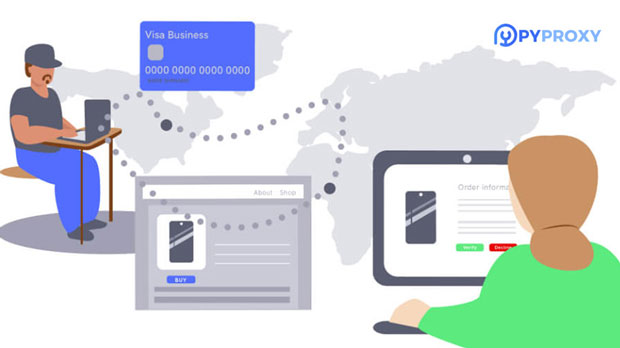Is SOCKS5 proxy software suitable for high-frequency network activities?
socks5 proxy is a popular network proxy protocol that provides users with higher privacy protection and flexible network access methods. However, with the continuous development of Internet applications, more and more users begin to pay attention to their performance in high-frequency network activities, especially in financial transactions, data capture, game acceleration and other scenarios, can SOCKS5 agents meet the needs of high frequency and high stability? This article will delve into the working principle, advantages, and disadvantages of SOCKS5 proxy, and explore whether it is suitable for application scenarios that require high-speed and high-frequency network operationsWhat is SOCKS5 proxy SOCKS5 proxy is an implementation of the fifth version of the SOCKS protocol (Socket Secure), which is mainly used to establish an intermediary layer between the client and server, helping users bypass geographical blocks, access restricted resources, or hide their IP addresses. Compared with previous generations of SOCKS protocols, SOCKS5 has higher flexibility and powerful functionality, supports multiple authentication methods, and can handle various types of network traffic (such as TCP, UDP). Its working principle is relatively simple, mainly forwarding user requests to the target server through relay packets, and then forwarding the response data back to the userThe main advantages of SOCKS5 proxy protocol include:1. Better privacy protection: It does not modify the content of the data packet, thus effectively avoiding information leakage caused by packet modifications2. Flexible protocol support: Supports TCP and UDP traffic, able to adapt to various types of network application requirements3. No need to encrypt traffic: The SOCKS5 protocol itself does not encrypt traffic, which means its impact on speed is relatively smallAlthough SOCKS5 proxy performs well in many scenarios, its suitability for high-frequency network activities requires in-depth analysis from multiple perspectivesCompatibility between SOCKS5 proxy and high-frequency network activitiesHigh frequency network activities refer to application scenarios that require extremely high network response time, data transmission speed, and stability, such as financial transactions, real-time data capture, and large-scale online games. Such activities often have strict requirements for the quality, latency, and throughput of network connections, so whether SOCKS5 agents can meet these requirements has become a key issueBefore analyzing this issue, we first need to clarify several core requirements for high-frequency network activities:1. Low latency: For real-time financial transactions or high-frequency data capture, any small fluctuations in latency can lead to significant losses. Therefore, the response speed of the proxy server must be very fast2. High bandwidth: High frequency activities usually require a large amount of data transmission, and the bandwidth capacity of proxy servers directly affects the efficiency of the activities3. Stability: Network fluctuations in high-frequency activities may lead to operational failures, therefore, the stability of proxy servers is also an important factor in measuring their suitability 1. Delay and high-frequency activity of SOCKS5 proxyThe working principle of SOCKS5 proxy determines that its latency is usually low, but it may still have some impact on high-frequency network activity. Due to the fact that the SOCKS5 protocol itself does not encrypt or modify data, it can maintain a relatively fast transmission speed to some extent. However, the level of latency not only depends on the SOCKS5 protocol itself, but is also closely related to the following factors:-The location of the proxy server: The geographical distance from the target server directly affects the latency of network transmission. If the proxy server is far away from the target server, the delay will inevitably increase-The load situation of the proxy server: When the connection volume of the proxy server is large, its performance may be affected, thereby increasing latency-Network bandwidth: The bandwidth of proxy servers is limited, and when the traffic is too large, it may also lead to increased transmission latencyFor high-frequency network activities that require extremely low latency, such as financial transactions and real-time data processing, SOCKS5 agents may not be able to meet the requirements. In contrast, direct connection to servers or dedicated VPN lines can provide more stable and low latency connections. Therefore, although SOCKS5 proxy can provide good latency performance in general network environments, its latency may become a bottleneck in high-frequency activities 2. The bandwidth and high-frequency activity of SOCKS5 proxyBandwidth is another important factor that affects high-frequency activity performance, especially in data intensive application scenarios. The bandwidth performance of SOCKS5 proxy depends on the following factors:-The hardware configuration of a proxy server: The processing power and network interface of the server determine its available bandwidth-Traffic management strategy: Some SOCKS5 proxy service providers may adopt traffic restrictions or bandwidth scheduling in high traffic situations, which may result in a decrease in the speed of high-frequency network activity-Response speed of the target server: Even if the SOCKS5 proxy can provide sufficient bandwidth, slow response from the target server can still affect overall performanceFor applications that require high bandwidth, such as large-scale data capture or high-definition video streaming, SOCKS5 proxy may provide sufficient support in bandwidth, but the prerequisite is to choose a high-performance proxy service. For high-frequency and bandwidth stable activities, especially in high traffic transmission scenarios, SOCKS5 proxy still has certain limitations 3. Stability and High Frequency Activity of SOCKS5 ProxyIn high-frequency network activities, network stability is crucial. Any network interruption, disconnection, or fluctuation may result in activity failure or data loss. The stability of SOCKS5 proxy is affected by the following factors:-The reliability of proxy servers: If proxy servers frequently experience failures or disconnections, it will directly affect the continuity of activities-Proxy server load: During high concurrency connections, excessive server load may result in delayed response or even disconnection-Changes in the network environment: The network environment of the Internet itself is full of variables, especially when accessing across regions, network fluctuations are inevitableFor high-frequency activities that place great emphasis on network stability, such as forex trading or automated stock market trading, SOCKS5 agents may not provide sufficient stability, especially in high traffic and high-frequency operations. Therefore, certain high-frequency activities may require dedicated lines or commercial grade proxy services to ensure network stabilityAdvantages and Disadvantages of SOCKS5 Proxy 1. Advantages of SOCKS5 Proxy-Privacy protection: SOCKS5 proxy can hide users' IP addresses and protect personal privacy, which is particularly important for many online activities-Support multiple protocols: SOCKS5 supports TCP and UDP protocols, which can adapt to more application scenarios-No encryption burden: SOCKS5 itself does not encrypt traffic, which makes it perform better than encryption protocols (such as VPN) in terms of bandwidth and latency 2. Shortcomings of SOCKS5 Proxy-Delay issue: Although SOCKS5 proxy has lower latency, its performance may still be inferior to direct connection or dedicated VPN lines in high-frequency activities-Bandwidth limitation: Some SOCKS5 proxy services have limited bandwidth, which may pose limitations on large-scale data transmission-Not suitable for high-frequency network activities: In network activities that require extremely low latency, high bandwidth, and high stability, the performance of SOCKS5 proxy may not be idealConclusion: Applicability of SOCKS5 Proxy in High Frequency Network ActivitiesOverall, SOCKS5 proxy performs well in many daily network activities, especially for scenarios that require privacy protection and bypass geographical blockades. However, in high-frequency network activities, SOCKS5 proxy may not be the best choice due to potential issues such as latency, bandwidth, and stability. For activities that require extremely high network performance, such as high-frequency financial transactions, real-time data scraping, etc., it may be necessary to consider more professional network solutions, such as dedicated VPNs, direct servers, or low latency dedicated line servicesTherefore, whether to choose SOCKS5 proxy depends on the specific usage scenario. If the demand for high-frequency network activities is relatively relaxed, SOCKS5 proxy is still an effective choice, but for tasks that strictly require low latency and high stability, other network connection methods may be more suitable.
2025-01-08

























































